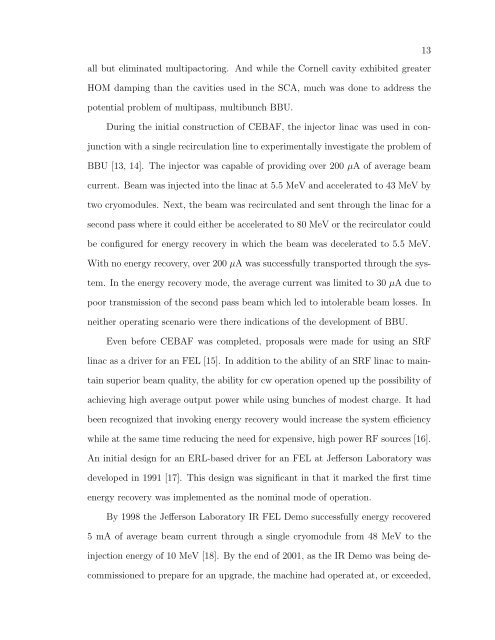STUDIES OF ENERGY RECOVERY LINACS AT ... - CASA
STUDIES OF ENERGY RECOVERY LINACS AT ... - CASA
STUDIES OF ENERGY RECOVERY LINACS AT ... - CASA
Create successful ePaper yourself
Turn your PDF publications into a flip-book with our unique Google optimized e-Paper software.
all but eliminated multipactoring. And while the Cornell cavity exhibited greater<br />
HOM damping than the cavities used in the SCA, much was done to address the<br />
potential problem of multipass, multibunch BBU.<br />
During the initial construction of CEBAF, the injector linac was used in con-<br />
junction with a single recirculation line to experimentally investigate the problem of<br />
BBU [13, 14]. The injector was capable of providing over 200 µA of average beam<br />
current. Beam was injected into the linac at 5.5 MeV and accelerated to 43 MeV by<br />
two cryomodules. Next, the beam was recirculated and sent through the linac for a<br />
second pass where it could either be accelerated to 80 MeV or the recirculator could<br />
be configured for energy recovery in which the beam was decelerated to 5.5 MeV.<br />
With no energy recovery, over 200 µA was successfully transported through the sys-<br />
tem. In the energy recovery mode, the average current was limited to 30 µA due to<br />
poor transmission of the second pass beam which led to intolerable beam losses. In<br />
neither operating scenario were there indications of the development of BBU.<br />
Even before CEBAF was completed, proposals were made for using an SRF<br />
linac as a driver for an FEL [15]. In addition to the ability of an SRF linac to main-<br />
tain superior beam quality, the ability for cw operation opened up the possibility of<br />
achieving high average output power while using bunches of modest charge. It had<br />
been recognized that invoking energy recovery would increase the system efficiency<br />
while at the same time reducing the need for expensive, high power RF sources [16].<br />
An initial design for an ERL-based driver for an FEL at Jefferson Laboratory was<br />
developed in 1991 [17]. This design was significant in that it marked the first time<br />
energy recovery was implemented as the nominal mode of operation.<br />
By 1998 the Jefferson Laboratory IR FEL Demo successfully energy recovered<br />
5 mA of average beam current through a single cryomodule from 48 MeV to the<br />
injection energy of 10 MeV [18]. By the end of 2001, as the IR Demo was being de-<br />
commissioned to prepare for an upgrade, the machine had operated at, or exceeded,<br />
13
















